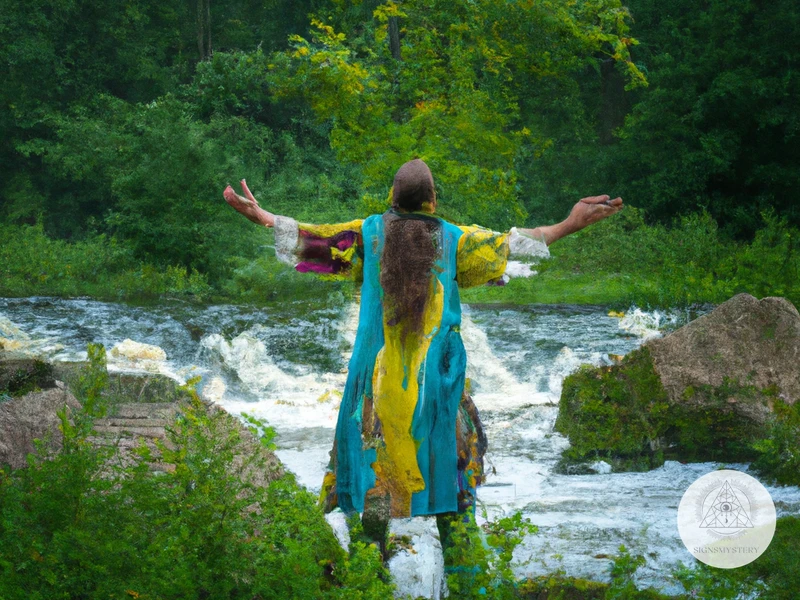For centuries, Siberian Shamanism has been one of the most enigmatic spiritual practices in the world. Originating in northern Asia, this ancient tradition is believed to be the oldest form of shamanism, dating back to tens of thousands of years. Siberian Shamanism is deeply rooted in the belief that all things, both animate and inanimate, have a spiritual essence, and that humans can communicate with them through various ritualistic practices. In this article, we will explore the fascinating history of Siberian Shamanism, its spiritual beliefs and practices, the role of the shaman in society, the importance of nature in the practice, and its current challenges and resurgence. So, let’s dive into the mysterious world of Siberian Shamanism and discover the ancient wisdom that has been passed down from generation to generation.
The History of Siberian Shamanism

Siberian Shamanism holds a unique place in the history of shamanism. Its roots can be traced back as far as 30,000 years ago, when the indigenous people of Siberia first utilized shamanic practices as a means of connecting with spirits and the natural world. Shamanism played a significant role in Siberian societies, and shamans were respected members of their communities due to their ability to communicate with the spirit world and provide guidance and healing for those in need. The practice of Siberian Shamanism evolved over time, with distinct forms emerging in different regions. Despite the challenges it has faced throughout history, Siberian Shamanism continues to influence spiritual practices worldwide. To learn more about the specifics of its development and practices, explore the subheadings below.
The Origins of Siberian Shamanism
Siberian Shamanism is considered to be the oldest form of shamanism in the world, with its origins dating back to the Paleolithic era. It is believed that the indigenous people of Siberia, known as the Siberian tribes, developed shamanic practices as a way of communicating with the spirits and gaining insights into the natural world around them.
The roots of Siberian Shamanism can be traced back to the nomadic tribes that inhabited the region over 40,000 years ago. These tribes lived in harmony with nature and were dependent on hunting and gathering for their existence. It is believed that it was during this time that the first shamanic practices emerged, as the tribes sought to connect with the spirits of nature to help them in their daily survival.
Over time, Siberian Shamanism developed into a complex spiritual tradition, with a wide range of practices and rituals. The shaman played a central role in these practices and was considered to be a mediator between the spiritual and physical worlds. The shaman was believed to have the power to communicate with spirits and to influence the natural world through ritual and magic.
Siberian Shamanism was not only a spiritual practice but also an integral part of the social and cultural life of the Siberian tribes. The shaman played an important role in healing, divination, and community leadership. It was the shaman who would lead the tribe in important ceremonies, such as birth, death, and marriage.
The origins of Siberian Shamanism are deeply rooted in the history and culture of the indigenous people of Siberia. This tradition has been passed down from generation to generation and has evolved over time to include many different practices and beliefs. Despite the many challenges faced by Siberian Shamanism over the centuries, it continues to be an important spiritual tradition today both in Siberia and throughout the world.
Development of Siberian Shamanism Through Time
Siberian Shamanism has a complex history that dates back to ancient times. The development of this practice has been shaped by various factors, including the region’s geography, culture, and social norms. Here are some of the key stages in the development of Siberian Shamanism:
| Period | Description |
|---|---|
| Paleolithic era | The early forms of shamanism in Siberia can be traced back to the Paleolithic era, when humans relied on hunting for survival. It is believed that the first shamans were hunters who used their spiritual abilities to communicate with animal spirits and ensure a successful hunt. |
| Bronze age | The Bronze Age saw the emergence of more organized forms of shamanism. Shamans started to play a more prominent role in society and were often consulted by community members for guidance on various issues. |
| Middle ages | During the Middle Ages, shamanism became even more widespread and diverse. Different regions developed their unique shamanic practices, and the use of hallucinogenic plants became more prevalent. Shamanic healing also became an essential aspect of the practice. |
| Post-colonization | The arrival of Europeans in Siberia had a significant impact on shamanism. The practice was suppressed and demonized, and many shamans were forced to abandon their traditions. However, some continued to practice shamanism in secret, and the practice survived through the Soviet era. |
| Contemporary era | In recent years, there has been a resurgence of interest in Siberian Shamanism among both native Siberians and people from other parts of the world. Some modern shamans adapt their practices to fit a contemporary context, while others try to preserve traditional methods. |
Understanding the historical development of Siberian Shamanism can help shed light on the origins of various practices and beliefs associated with this ancient form of spirituality. For example, the use of hallucinogenic plants can be traced back to the Middle Ages, while the importance of hunting and animal spirits dates back to the Paleolithic era.
Spiritual Beliefs and Practices
Siberian Shamanism holds a strong spiritual belief in Animism, which is the concept that all things, including inanimate objects, have a living soul. Through the practice of Shamanic Journeying, the shaman is able to access the spirit world and communicate with these animate and inanimate spirits. Shamanic Journeying often involves the shaman using shamanic tools and instruments such as drums or rattles to facilitate the trance-like state necessary for journeying. The practice of magic, divination, and healing also plays a central role in Siberian Shamanism. Many modern-day practitioners continue to use these traditional practices to connect with their ancestral roots and to bring healing to themselves and others. For those interested in learning more about Shamanic Journeying, visit /siberian-shamanic-journey-features/ for more information.
Animism and Shamanic Journeying
Animism is a central spiritual belief in Siberian Shamanism. It is the idea that all objects and beings have a soul, a consciousness, and a spirit, including inanimate objects like rocks, trees, and mountains. Shamanic journeying is a practice in which a shaman enters a trance-like state to connect with the spiritual realm and retrieve information, guidance, or healing for themselves or their community. Shamans use various techniques to achieve this state of consciousness, including meditation, drumming, chanting, and using natural hallucinogens like mushrooms, roots, or leaves.
In Siberian Shamanism, animism and shamanic journeying are intertwined concepts. When a shaman journeys, they encounter spirits, such as nature spirits, deities, or ancestral spirits. They seek their wisdom, knowledge, and protection. Siberian shamans believe that spirits exist in every aspect of nature, from the smallest pebble to the largest mountain range. Spirits of trees, water, animals, and the land itself are present in every shamanic journey.
The journey itself is not just a mental exploration but a physical one too. During the journeying, shamans might change their form, speak with animals, or travel down a river into the underworld. These experiences provide insight into the interconnectedness of all things and their spiritual significance.
Siberian Shamanism holds that every living and nonliving entity in the world is connected through the web of life. An important aspect of animism is the balance between nature and human beings. Shamans aim to maintain the balance by appeasing the spirits and offering them respect, care, and honor. Every action has consequences and every relationship ingrained in animism is one of reciprocal exchange. Their respect for nature contributes to their ethos of environmental conservation and preservation.
Animism and shamanic journeying are the cornerstones of Siberian Shamanism. Through journeying, shamans aim to connect with the spiritual realm and the spirits that inhabit nature. The belief in animism and the spirit world has been instrumental in the preservation of the natural environment in Siberia. If you are interested in comparing Siberian Shamanism with other shamanic practices, you can read about it on our website or explore other topics like the role of reindeer, shamanic tools, and contemporary realities of this oldest form of shamanism.
Magic, Divination, and Healing
Siberian shamanism places great importance on the power of magic, divination, and healing. These practices are deeply ingrained in Siberian shamanic culture and are believed to help individuals connect with spiritual energies, receive guidance, and maintain balance and harmony in life.
| Magic | Divination | Healing |
|---|---|---|
| Siberian shamans believe in the power of magic to influence the physical world. They use spells and incantations to protect individuals from harm, bring good fortune and success, and ward off evil spirits. Shamans also perform magical ceremonies to help people overcome obstacles in their lives. | Siberian shamanism relies heavily on divination, which is the practice of seeking knowledge of the future or the unknown by supernatural means. Divination methods used by Siberian shamans include the interpretation of dreams, reading of omens, and the use of animal bones or other objects to unravel the secrets of the spirit world. | Siberian shamanism views the mind, body, and spirit as interconnected, and therefore, healing is both a physical and spiritual process. Shamans use a variety of techniques, such as energy healing, herbal remedies, and soul-retrieval, to heal physical and emotional ailments. They work closely with spirit guides and power animals to understand the root causes of an illness and to facilitate its healing. |
Siberian shamans believe that illness and imbalance can result from unresolved emotions or spiritual disconnection, and that through healing, individuals can achieve greater spiritual awareness and personal growth. These practices have been passed down through generations and remain a vital aspect of Siberian shamanic culture.
If you’re interested in comparing Siberian shamanism to other shamanic traditions around the world, we have an article on comparing Siberian shamanism. Alternatively, you can read more about the healing practices of Siberian shamans in our article on healing in Siberian shamanism. If you’re interested in learning how Siberian shamans perceive nature and nature spirits, check out our article on Siberian shamanic beliefs about nature spirits.
Role of the Shaman in Society

The shaman played a significant role in Siberian society. They were seen as mediators between the human and spirit worlds, and their abilities to connect with the spirit world made them valuable members of their communities. The shaman’s primary function was to maintain the balance and harmony between the physical and spiritual worlds. They accomplished this through their rituals, which involved singing, drumming, dancing, and other trance-inducing techniques.
In addition to their spiritual duties, the shaman also had practical responsibilities. They acted as the community’s medical practitioners, healers, and counselors. They were responsible for diagnosing and treating illnesses, often using natural remedies and shamanic tools and instruments to aid in their healing practices. The shaman also provided guidance to individuals and the community as a whole, helping resolve conflicts and providing insights into future events through their divination techniques.
The shaman’s role in society extended beyond their spiritual and practical responsibilities. They also played important roles in social and political events. The shaman would often perform at community gatherings and festivals, providing entertainment and spiritual guidance. They also played crucial roles in negotiating alliances and resolving disputes between different communities.
However, with the rise of Soviet power, shamanism was marginalized, and its influence in Siberian society was diminished. The Soviet government considered shamanism a form of superstition and actively worked to eliminate it. Many shamans were killed, and their practices were forced underground.
Despite the challenges faced by the traditional practice of Siberian shamanism, it has experienced a resurgence and revival in recent years. There is renewed interest in modern Siberian shamanism, which incorporates traditional practices with modern spiritual and ecological perspectives. The importance of shamanism in Siberian culture is being recognized, and efforts are being made to preserve and revive traditional practices.
The shaman had a central role in traditional Siberian society, acting as spiritual intermediaries, healers, and counselors. They played practical, political, and social functions in their communities, maintaining balance and harmony between the physical and spiritual worlds. While shamanism faced significant challenges during the Soviet era, it has experienced a resurgence in recent years, with a renewed interest in preserving and reviving its traditional practices.
The Importance of Nature in Siberian Shamanism
Nature plays a vital role in Siberian Shamanism belief system, as it is believed that all things in the world are interconnected and interdependent. Nature is seen as a living organism, and each living being has an animating spirit, or ‘numen,’ which the shaman can communicate with during his or her journeying. The shaman also believes that he or she is a part of nature, and that the act of performing shamanic ritual connects the shaman to the natural world.
Use of natural materials
To connect with nature, the shaman employs the use of natural materials in their rituals, including feathers, bones, stones, and plants. These materials are believed to have spiritual energy and can be used to communicate with spirits, and to
Subscribe to Our Newsletter
Sign up to receive the latest news and updates.
Connection with the animal world
In Siberian Shamanism, the animal world holds a central place. Shamans believe that each animal has a specific spirit that can be communicated with, and that each animal can teach the shaman a specific lesson. For example, the reindeer is a particularly important animal to the Tsaatan people in Mongolia. The Tsaatan rely on reindeer for transportation and food, and as such, the reindeer has become a central aspect of their religious beliefs. The reindeer is seen not only as a source of nourishment but also as a spiritual guide, and its antlers are often used in shamanic rituals.
Importance of the natural environment
Siberia is a region known for its harsh climate and extreme natural environment. The shaman’s connection to nature reflects the daily struggle of the people who live in the region. The shaman engages with the natural environment and its challenges in a way that helps to alleviate the people’s spiritual and physical suffering.
One of the most important aspects of nature in Siberian Shamanism is the belief that everything in nature deserves respect and deserves to be treated with care. When humans do not respect the natural world, it is thought to have negative consequences for the entire community. Thus, shamans and their followers work to maintain a harmonious relationship with the environment.
Internal link
To learn more about the importance of the reindeer in Siberian Shamanism, read our article on reindeer and shamanism.
Contemporary Siberian Shamanism
In contemporary Siberian shamanism, there are still shamans who continue to practice and uphold the traditions of their ancestors. However, the practice has faced challenges in recent years from modernization, globalization, and government suppression. Despite these challenges, there has been a resurgence and revival of Siberian shamanism, with an increasing interest in the indigenous spiritual practices of the region. Some contemporary shamans have adapted their practices to integrate modern tools and technologies, such as using social media to connect with clients and offer distant healing. Others have formed organizations and community groups to preserve and promote the traditional ways of Siberian shamanism. Contemporary Siberian shamanism is a dynamic and evolving practice that is continuing to adapt and evolve in the modern world.
Challenges to the Practice Today
Siberian shamanism has faced many challenges in recent times. Some of these challenges are external while others are internal. External challenges include the suppression of indigenous cultures and religions by colonial powers and the dominant culture. In Siberia, this suppression began with the arrival of Russian Orthodox Christianity in the 16th century, which often involved the forceful conversion of indigenous peoples. This suppression continued during the Soviet era when atheism was the official state policy and many shamanic practices were considered counter-revolutionary and punishable by imprisonment or death.
Another external challenge is the commercialization of shamanism in Western societies. This has led to a surge of interest in shamanism among non-indigenous people, resulting in the commodification of indigenous culture and practices. This can be seen in the proliferation of shamanic retreats, workshops, and online courses offered by non-indigenous practitioners. This commercialization often lacks the cultural context and respect necessary for the practice to be effective and authentic.
Internal challenges to the practice today include the loss of traditional knowledge and the disconnection between generations. Many indigenous communities have been disrupted by the forced migration to urban areas, resulting in the loss of knowledge and practices that are specific to a certain region or community. Additionally, younger generations often do not see the relevance of shamanism in their lives and are not interested in carrying on the tradition.
Another internal challenge is the tension between traditional shamanism and modernity. As communities become more integrated into the global economy and adopt more modern practices, the traditional ways of shamanism may be seen as outdated or irrelevant. This can lead to a loss of respect for traditional practices and a decline in the number of people who practice shamanism.
Despite these challenges, there is hope for the continuation of Siberian shamanism. Indigenous communities are working to preserve and promote their traditional practices through education and cultural programs. There is also a growing interest among non-indigenous people in learning about and respecting indigenous cultures and practices. By addressing these challenges and working towards preserving and respecting traditional knowledge, Siberian shamanism can continue to thrive for generations to come.
Resurgence and Revival in Recent Years
In recent years, there has been a resurgence and revival of Siberian Shamanism. This is partly due to the increasing interest in spiritual practices and the desire to connect with nature. Many people are also searching for an alternative to traditional Western medicine.
One reason for this resurgence is the availability of information about the practice online. People are able to learn about Siberian Shamanism even if they don’t have access to a local Shaman. Websites, social media platforms, and online forums have all contributed to the spread of information about the practice.
Another factor contributing to the revival is the rise of Shamanic tourism in Siberia. Many Westerners are attracted to the idea of experiencing traditional Shamanic practices first-hand. They travel to Siberia to participate in rituals and gain a deeper understanding of the practice.
The use of Siberian Shamanism in psychotherapy is also contributing to its resurgence. Some therapists are incorporating Shamanic practices into their treatment plans for patients suffering from depression, anxiety, and PTSD.
Despite the increased interest in Siberian Shamanism, there are still challenges facing the practice. One of the biggest challenges is the loss of traditional Shamanic knowledge and practices due to the suppression of the practice during the Soviet era.
The resurgence and revival of Siberian Shamanism in recent years is giving people a new way to connect with nature and explore their spirituality. With the availability of information online, the rise of Shamanic tourism, and the use of Shamanism in psychotherapy, the practice is gaining new followers and becoming more widely accepted.
Conclusion
As we conclude this article, it is clear that Siberian Shamanism is the oldest form of shamanism in the world. It has been practiced for centuries by the indigenous people of Siberia and continues to be practiced by some to this day.
Siberian Shamanism is a complex and multifaceted spiritual system that centers on the shaman’s ability to journey into the spiritual realm to communicate with and manipulate spiritual entities. This system also involves a deep reverence for nature and its elementals, as well as the use of various forms of magic and divination for the purpose of healing and maintaining balance in the world.
Throughout history, Siberian Shamanism has faced numerous challenges and periods of decline, including the influences of modernization and the suppression of indigenous cultures by colonial powers. However, in recent years, there has been a resurgence of interest in this ancient practice, with many seeking to preserve and revive its traditions.
The role of the shaman in society was and still is a significant one. They were not only spiritual leaders and healers but also community mediators and advisers. The importance of nature in Siberian Shamanism cannot be overstated, and it plays a crucial role in the shaman’s journey and their connection to the spiritual realm.
In conclusion, Siberian Shamanism is a fascinating and deeply spiritual practice that offers an insight into the wisdom of indigenous cultures. Its survival and revival in recent years are a testament to its enduring relevance and importance as a spiritual tradition. Through its continued practice and study, we can gain a better understanding of our place in the natural world and the spiritual realm beyond it.
Frequently Asked Questions
What is Siberian Shamanism?
Siberian shamanism is the oldest form of shamanism, originating from the indigenous peoples of Siberia. It is a spiritual practice that involves communicating with spirits, ancestors, and the natural world through rituals, ceremonies, and trance.
What are the origins of Siberian Shamanism?
The origins of Siberian shamanism are believed to date back to the Paleolithic era, with evidence of shamanic practices found in archaeological finds from the region. Shamanism evolved as a way for indigenous peoples to connect with nature, the elements, and other spiritual realms.
What are animism and shamanic journeying?
Animism is the belief that everything in the natural world has a spirit or soul. In shamanic journeying, the shaman enters a trance state to journey through different realms, communicating with spirits and gathering information and healing for others.
What are the magical and divination practices in Siberian Shamanism?
Siberian shamanism involves various magical and divination practices, including the use of drums, rattles, and other instruments to create a trance state, divination through smoke and fire, and the use of natural elements such as stones and bones for casting and interpreting omens.
What is the role of the shaman in Siberian society?
The shaman in Siberian society is a spiritual leader and healer, responsible for communicating with spirits and guiding the community through important life stages such as birth, marriage, and death. They also provide guidance and mediate conflicts within the community.
How important is nature in Siberian Shamanism?
Nature is crucial in Siberian shamanism, as the natural world is believed to be alive and full of spirits. The shaman often works directly with natural elements such as water, rocks, and plants to access spiritual realms and bring healing or guidance to people.
What are the challenges facing traditional Siberian Shamanism today?
Traditional Siberian shamanism faces many challenges today, including cultural and environmental degradation, suppression by dominant religions, and a lack of support for traditional spiritual practices.
What is the resurgence of Siberian Shamanism?
Recent years have seen a revival in traditional Siberian shamanism, with increased interest in indigenous spirituality and a push for cultural preservation. Many indigenous communities are working to re-establish shamanic practices and educate others about their cultural heritage.
Is Siberian Shamanism considered a religion?
While Siberian shamanism has many elements that could be considered religious, it is not typically classified as a religion in the traditional sense. Rather, it is a spiritual practice that is deeply connected to nature and the spiritual realms.
Can anyone become a Siberian shaman?
The path to becoming a Siberian shaman is a complex and difficult one, involving years of training, initiation, and spiritual guidance. It is typically only open to those within the indigenous communities that practice shamanism and is not easily accessible to outsiders.










